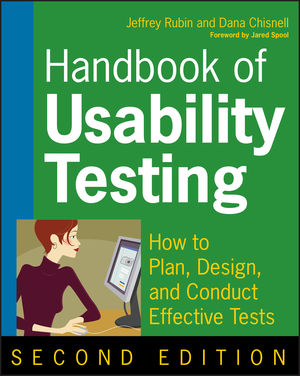Handbook of Usability Testing: How to Plan, Design, and Conduct Effective Tests, 2nd EditionISBN: 978-0-470-18548-3
Paperback
384 pages
May 2008
 |
||||||
Acknowledgments xi
Foreword xxix
Preface to the Second Edition xxxiii
Part One Usability Testing: An Overview
Chapter 1 What Makes Something Usable? 3
What Do We Mean by ‘‘Usable’’? 4
What Makes Something Less Usable? 6
WhatMakes Products MoreUsable? 12
What Are Techniques for Building in Usability? 16
Chapter 2 What Is Usability Testing? 21
Why Test? Goals of Testing 21
Basics of the Methodology 23
Chapter 3 When Should You Test? 27
Our Types of Tests: An Overview 27
Exploratory or Formative Study 29
Assessment or Summative Test 34
Validation or Verification Test 35
Overview of the Methodology 36
Comparison Test 37
Iterative Testing: Test Types through the Lifecycle 39
Chapter 4 Skills for Test Moderators 45
Characteristics of a Good Test Moderator 48
Getting the Most out of Your Participants 52
Troubleshooting Typical Moderating Problems 56
How to Improve Your Session-Moderating Skills 58
Part Two The Process for Conducting a Test
Chapter 5 Develop the Test Plan 65
Why Create a Test Plan? 65
The Parts of a Test Plan 67
Sample Test Plan 91
Chapter 6 Set Up a Testing Environment 93
Decide on a Location and Space 94
Recommended Testing Environment: Minimalist Portable Lab 110
Gather and Check Equipment, Artifacts, and Tools 111
Identify Co-Researchers, Assistants, and Observers 112
Chapter 7 Find and Select Participants 115
Characterize Users 115
Define the Criteria for Each User Group 119
Determine the Number of Participants to Test 125
Write the Screening Questionnaire 126
Find Sources of Participants 131
Screen and Select Participants 143
Schedule and Confirm Participants 148
Chapter 8 Prepare Test Materials 153
Guidelines for Observers 154
Orientation Script 155
Background Questionnaire 162
Data Collection Tools 165
Nondisclosures, Consent Forms, and Recording Waivers 173
Pre-Test Questionnaires and Interviews 174
Prototypes or Products to Test 181
Task Scenarios 182
Optional Training Materials 187
Use the Research Questions(s) from the Test Plan as the Basis for Your Content 193
Common Question Formats 197
Debriefing Guide 199
Chapter 9 Conduct the Test Sessions 201
Guidelines for Moderating Test Sessions 202
Checklists for Getting Ready 213
When to Intervene 225
What Not to Say to Participants 227
Chapter 10 Debrief the Participant and Observers 229
Why Review with Participants and Observers? 229
Techniques for Reviewing with Participants 230
Where to Hold the Participant Debriefing Session 231
Basic Debriefing Guidelines 231
Advanced Debriefing Guidelines and Techniques 235
Reviewing and Reaching Consensus with Observers 241
Chapter 11 Analyze Data and Observations 245
Compile Data 246
Summarize Data 249
Analyze Data 258
Chapter 12 Report Findings and Recommendations 269
What Is a Finding? 269
Shape the Findings 269
Draft the Report 271
Develop Recommendations 277
Refine the Report Format 283
Create a Highlights Video or Presentation 283
Part Three Advanced Techniques
Chapter 13 Variations on the Basic Method 293
Who? Testing with Special Populations 293
What: Prototypes versus Real Products 299
How? Techniques for Monitored Tests 302
Where? Testing Outside a Lab 309
Self-Reporting (Surveys, Diary Studies) 313
Chapter 14 Expanding from Usability Testing to Designing the User Experience 315
Stealth Mode: Establish Value 316
Build on Successes 322
Formalize Processes and Practices 323
Expand UCD throughout the Organization 328
Afterword 333
Index 335



